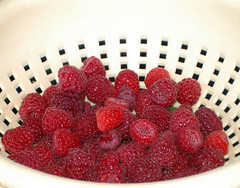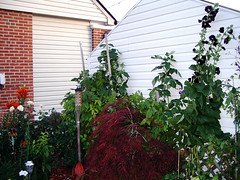Did I tell you that I grow raspberries?
 Now doesn’t that look yummy?
Now doesn’t that look yummy?
The raspberry bushes are one of the few plants left in the yard by the original owners. I’ve changed pretty much everything else. Well, there wasn’t much to begin with, but I knew during that first summer, as I picked a colander full of raspberries almost each day, that the most of the bushes would be staying.
Originally, there had been perhaps more than 50 raspberry bushes in the back right hand corner of the yard. Lovely for the fruity benefits, but not so great when I decided to landscape during the spring of 2002 in order to begin my lovely rose garden. I only left about 15 plants when I created what is now my raised garden beds. In the years since, the plants have started to multiply, and I think there are likely 25 bushes out there.
Growing Raspberries:
Would you like to grow your own raspberries in your yard? Here’s how.
Nothing caps a summer evening better than a raspberry smoothie, or a bowl of fresh raspberries and cream. Ripe berries sprinkled on cereal in the morning is always nice too. Because of their delicious uses and ease of growing, the perennial raspberry ought to be in every garden.
The most commonly grown raspberry is the red, but the purple and black type make interesting variations on the raspberry theme. All can be grown in most zones and they are self fertile. To make the most of your raspberry patch check with your local nursery or county extension to make sure that the variety that you want to buy will thrive in your area.
Planting:
Moisture and plenty of rich organic matter in the soil are essentials. When deciding on a location, look for a spot that gets some protection from the blustery cold winds of winter. To improve the soils ability to retain moisture, work in plenty of well rotted manure or sphagnum peat moss.
Set the bushes in the ground as soon as you bring them home from the nursery. If roots appear dried out, soak them in water for an hour or two before planting. Red raspberries can be planted two or three inches deeper than at the nursery. black and purple varieties should be planted at the same depth. Space plants three feet apart and rows five to eight feet apart. (Needless to say my plants are much closer together than that in my tiny backyard.)
 My raspberry plants are sheltered behind my neighbors garage. In this photo you can see them beginning at the Japanese Maple with the row going back towards another neighbors house.
My raspberry plants are sheltered behind my neighbors garage. In this photo you can see them beginning at the Japanese Maple with the row going back towards another neighbors house.
Care and Feeding:
After the canes have been set out, cut back central canes to a height of six inches, then mulch to conserve moisture.
When plants are dormant in early spring remove weak and spindly canes. Then remove any suckers that have grown up between the rows. If properly pruned raspberry canes are self supporting. Cut back your black raspberry varieties to 18 to 24 inches; purple and red varieties to 30 to 36 inches. the amount and the quality of the fruit will be greatly improved if lateral branches are trimmed back to at least four to six buds.
In the Autumn remove all old, spent canes and destroy them.
Insects and Diseases:
Raspberries are hardly immune from disease and insect attack, but problems will be few if you practice good garden hygiene. Purchase only healthy disease resistant plants from a trust worthy nursery or garden center.
Make sure that old canes are removed and destroyed so insect larvae and fungus spores don’t overwinter. If a plant appears doomed because of disease, remove it immediately so that the other plants don’t become affected.
Now that you know how to grow your own raspberries I think I’ll go fix myself a small bowl of raspberries. Mmmmm delicious.
We planted our raspberries in a raised bed this year – which was lined with a weed barrier to try and contain the plants. Hopefully it will work. The plants are growing very well and so far no randam stalks appearing where they shouldn’t. As long as the barrier stays in place, we should be okay!!!